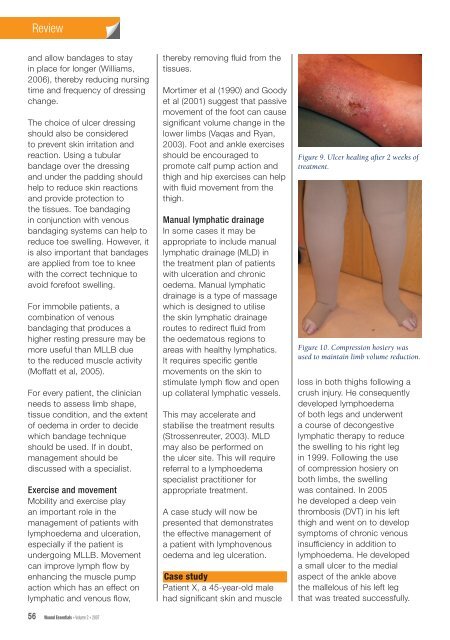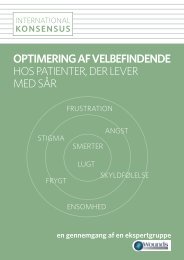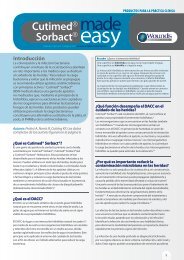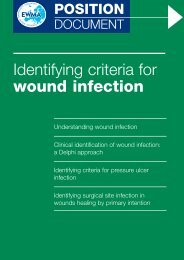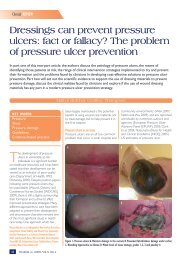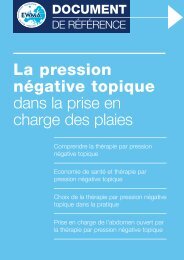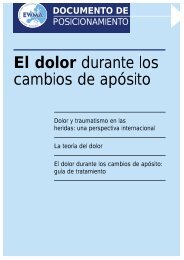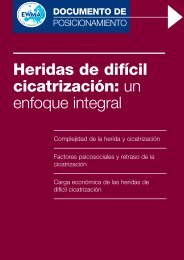leg ulcer management in patients with chronic oedema - Wounds ...
leg ulcer management in patients with chronic oedema - Wounds ...
leg ulcer management in patients with chronic oedema - Wounds ...
You also want an ePaper? Increase the reach of your titles
YUMPU automatically turns print PDFs into web optimized ePapers that Google loves.
Reviewand allow bandages to stay<strong>in</strong> place for longer (Williams,2006), thereby reduc<strong>in</strong>g nurs<strong>in</strong>gtime and frequency of dress<strong>in</strong>gchange.The choice of <strong>ulcer</strong> dress<strong>in</strong>gshould also be consideredto prevent sk<strong>in</strong> irritation andreaction. Us<strong>in</strong>g a tubularbandage over the dress<strong>in</strong>gand under the padd<strong>in</strong>g shouldhelp to reduce sk<strong>in</strong> reactionsand provide protection tothe tissues. Toe bandag<strong>in</strong>g<strong>in</strong> conjunction <strong>with</strong> venousbandag<strong>in</strong>g systems can help toreduce toe swell<strong>in</strong>g. However, itis also important that bandagesare applied from toe to knee<strong>with</strong> the correct technique toavoid forefoot swell<strong>in</strong>g.For immobile <strong>patients</strong>, acomb<strong>in</strong>ation of venousbandag<strong>in</strong>g that produces ahigher rest<strong>in</strong>g pressure may bemore useful than MLLB dueto the reduced muscle activity(Moffatt et al, 2005).For every patient, the cl<strong>in</strong>icianneeds to assess limb shape,tissue condition, and the extentof <strong>oedema</strong> <strong>in</strong> order to decidewhich bandage techniqueshould be used. If <strong>in</strong> doubt,<strong>management</strong> should bediscussed <strong>with</strong> a specialist.Exercise and movementMobility and exercise playan important role <strong>in</strong> the<strong>management</strong> of <strong>patients</strong> <strong>with</strong>lymph<strong>oedema</strong> and <strong>ulcer</strong>ation,especially if the patient isundergo<strong>in</strong>g MLLB. Movementcan improve lymph flow byenhanc<strong>in</strong>g the muscle pumpaction which has an effect onlymphatic and venous flow,thereby remov<strong>in</strong>g fluid from thetissues.Mortimer et al (1990) and Goodyet al (2001) suggest that passivemovement of the foot can causesignificant volume change <strong>in</strong> thelower limbs (Vaqas and Ryan,2003). Foot and ankle exercisesshould be encouraged topromote calf pump action andthigh and hip exercises can help<strong>with</strong> fluid movement from thethigh.Manual lymphatic dra<strong>in</strong>ageIn some cases it may beappropriate to <strong>in</strong>clude manuallymphatic dra<strong>in</strong>age (MLD) <strong>in</strong>the treatment plan of <strong>patients</strong><strong>with</strong> <strong>ulcer</strong>ation and <strong>chronic</strong><strong>oedema</strong>. Manual lymphaticdra<strong>in</strong>age is a type of massagewhich is designed to utilisethe sk<strong>in</strong> lymphatic dra<strong>in</strong>ageroutes to redirect fluid fromthe <strong>oedema</strong>tous regions toareas <strong>with</strong> healthy lymphatics.It requires specific gentlemovements on the sk<strong>in</strong> tostimulate lymph flow and openup collateral lymphatic vessels.This may accelerate andstabilise the treatment results(Strossenreuter, 2003). MLDmay also be performed onthe <strong>ulcer</strong> site. This will requirereferral to a lymph<strong>oedema</strong>specialist practitioner forappropriate treatment.A case study will now bepresented that demonstratesthe effective <strong>management</strong> ofa patient <strong>with</strong> lymphovenous<strong>oedema</strong> and <strong>leg</strong> <strong>ulcer</strong>ation.Case studyPatient X, a 45-year-old malehad significant sk<strong>in</strong> and muscleFigure 9. Ulcer heal<strong>in</strong>g after 2 weeks oftreatment.Figure 10. Compression hosiery wasused to ma<strong>in</strong>ta<strong>in</strong> limb volume reduction.loss <strong>in</strong> both thighs follow<strong>in</strong>g acrush <strong>in</strong>jury. He consequentlydeveloped lymph<strong>oedema</strong>of both <strong>leg</strong>s and underwenta course of decongestivelymphatic therapy to reducethe swell<strong>in</strong>g to his right <strong>leg</strong><strong>in</strong> 1999. Follow<strong>in</strong>g the useof compression hosiery onboth limbs, the swell<strong>in</strong>gwas conta<strong>in</strong>ed. In 2005he developed a deep ve<strong>in</strong>thrombosis (DVT) <strong>in</strong> his leftthigh and went on to developsymptoms of <strong>chronic</strong> venous<strong>in</strong>sufficiency <strong>in</strong> addition tolymph<strong>oedema</strong>. He developeda small <strong>ulcer</strong> to the medialaspect of the ankle abovethe mallelous of his left <strong>leg</strong>that was treated successfully.56 Wound Essentials • Volume 2 • 2007


